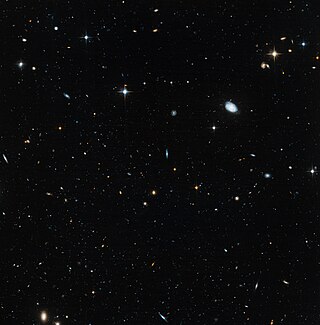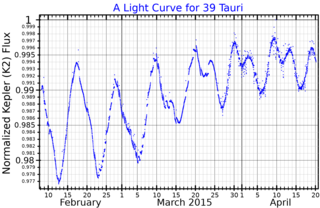Ross 248, also called HH Andromedae or Gliese 905, is a small star approximately 10.30 light-years from Earth in the northern constellation of Andromeda. Despite its proximity it is too dim to be seen with the naked eye. It was first catalogued by Frank Elmore Ross in 1926 with his second list of proper-motion stars; on which count it ranks 261st in the SIMBAD database. It was too dim to be included in the Hipparcos survey. In about 40,000 years, Voyager 2 will pass 1.7 light-years from the star.
Peculiar motion or peculiar velocity refers to the velocity of an object relative to a rest frame — usually a frame in which the average velocity of some objects is zero.

The Orion Arm, also known as the Orion–Cygnus Arm, is a minor spiral arm within the Milky Way Galaxy spanning 3,500 light-years in width and extending roughly 10,000 light-years in length. This galactic structure encompasses the Solar System, including Earth. It is sometimes referred to by alternate names such as the Local Arm or Orion Bridge, and it was previously identified as the Local Spur or the Orion Spur. It should not be confused with the outer terminus of the Norma Arm, known as the Cygnus Arm.

A galactic disc is a component of disc galaxies, such as spiral galaxies, lenticular galaxies, and the Milky Way. Galactic discs consist of a stellar component and a gaseous component. The stellar population of galactic discs tend to exhibit very little random motion with most of its stars undergoing nearly circular orbits about the galactic center. Discs can be fairly thin because the disc material's motion lies predominantly on the plane of the disc. The Milky Way's disc, for example, is approximately 1 kly thick, but thickness can vary for discs in other galaxies.

The Milky Way is the galaxy that includes the Solar System, with the name describing the galaxy's appearance from Earth: a hazy band of light seen in the night sky formed from stars that cannot be individually distinguished by the naked eye. The term Milky Way is a translation of the Latin via lactea, from the Greek γαλαξίας κύκλος, meaning "milky circle". From Earth, the Milky Way appears as a band because its disk-shaped structure is viewed from within. Galileo Galilei first resolved the band of light into individual stars with his telescope in 1610. Until the early 1920s, most astronomers thought that the Milky Way contained all the stars in the Universe. Following the 1920 Great Debate between the astronomers Harlow Shapley and Heber Doust Curtis, observations by Edwin Hubble showed that the Milky Way is just one of many galaxies.

The Andromeda–Milky Way collision is a galactic collision predicted to occur in about 4.5 billion years between the two largest galaxies in the Local Group—the Milky Way and the Andromeda Galaxy. The stars involved are sufficiently far apart that it is improbable that any of them will individually collide, though some stars will be ejected.
Segue 1 is a dwarf spheroidal galaxy or globular cluster situated in the Leo constellation and discovered in 2006 by Sloan Digital Sky Survey. It is located at a distance of about 23 kpc from the Sun and moves away from the Sun with the velocity of about 206 km/s. Segue 1 has a noticeably elongated shape with the half-light radius of about 30 pc. This elongation may be caused by the tidal forces acting from the Milky Way galaxy if Segue 1 is being tidally disrupted now.

In astronomy, stellar kinematics is the observational study or measurement of the kinematics or motions of stars through space.

Leo IV is a dwarf spheroidal galaxy situated in the Leo constellation, discovered in 2006 in the data obtained by the Sloan Digital Sky Survey. The galaxy is located at the distance of about 160 kpc from the Sun and moves away from the Sun with the velocity of about 130 km/s. It is classified as a dwarf spheroidal galaxy (dSph) meaning that it has an approximately round shape with the half-light radius of about 130 pc.
Coma Berenices or Com is a dwarf spheroidal galaxy situated in the Coma Berenices constellation and discovered in 2006 in data obtained by the Sloan Digital Sky Survey. The galaxy is located at the distance of about 44 kpc from the Sun and moves away from the Sun with the velocity of about 98 km/s. It is classified as a dwarf spheroidal galaxy (dSph) meaning that it has an elliptical shape with the half-light radius of about 70 pc.
HD 196761 is the Henry Draper Catalogue designation for a G-type main-sequence star in the constellation Capricornus. With an apparent magnitude of 6.37 it is near the limit of what can be seen with the naked eye, but according to the Bortle Scale it may be possible to view it at night from rural skies. Based upon parallax measurements by the Hipparcos spacecraft, it is located about 47 light years from the Solar System.

Hercules, or Her, is a dwarf spheroidal galaxy situated in the Hercules constellation and discovered in 2006 in data obtained by the Sloan Digital Sky Survey. The galaxy is located at a distance of about 140 kpc from the Sun and moves away from the Sun with a velocity of about 45 km/s. It is classified as a dwarf spheroidal galaxy (dSph). It has a noticeably elongated shape with a half-light radius of about 350 pc. This elongation may be caused by tidal forces acting from the Milky Way galaxy, meaning that Her is being tidally disrupted now. Her also shows some gradient of velocities across the galaxy's body and is embedded into a faint stellar stream, which also points towards its ongoing tidal disruption.
Boötes III is an overdensity in the Milky Way's halo, which may be a disrupted dwarf spheroidal galaxy. It is situated in the constellation Boötes and was discovered in 2009 in the data obtained by Sloan Digital Sky Survey. The galaxy is located at the distance of about 46 kpc from the Sun and moves away from it at the speed of about 200 km/s. It has an elongated shape with the radius of about 0.5 kpc. The large size and an irregular shape may indicate that Boötes III in a transitional phase between a gravitationally bound galaxy and completely unbound system.

LSR J1835+3259 is a nearby ultracool dwarf of spectral class M8.5, located in constellation Lyra, the discovery of which was published in 2003. Previously it was concluded that this star is a young brown dwarf, but no lithium absorption lines are detected for this object, which is a strong indicator for young brown dwarfs that need 10-100 million years to deplete lithium.

The thick disk is one of the structural components of about 2/3 of all disk galaxies, including the Milky Way. It was discovered first in external edge-on galaxies. Soon after, it was proposed as a distinct galactic structure in the Milky Way, different from the thin disk and the halo in the 1983 article by Gilmore & Reid. It is supposed to dominate the stellar number density between 1 and 5 kiloparsecs above the galactic plane and, in the solar neighborhood, is composed almost exclusively of older stars. Its stellar chemistry and stellar kinematics are also said to set it apart from the thin disk. Compared to the thin disk, thick disk stars typically have significantly lower levels of metals—that is, the abundance of elements other than hydrogen and helium.
18 Camelopardalis is a yellow-white-hued star in the northern circumpolar constellation of Camelopardalis. It has an apparent visual magnitude is 6.44, which makes it a challenge to view with the naked eye. Using the measured annual parallax shift of 23.02 mas, its distance can be estimated at 142 light-years. The star is moving away from the Sun with a radial velocity of +33 km/s and has an annual proper motion of 0.251 arcseconds.
Xi Pegasi is the Bayer designation for a double star in the northern constellation of Pegasus, the winged horse. Located in the horse's neck, the primary component is an F-type main sequence star that is visible to the naked eye with an apparent visual magnitude of 4.2. It is 86% larger and 17% more massive that the Sun, radiating 4.5 times the solar luminosity. Based upon parallax measurements taken with the Hipparcos spacecraft, it is located 53.2 ± 0.2 light years from the Sun.
84 Ceti is the Flamsteed designation for a binary star system in the equatorial constellation of Cetus. It has an apparent visual magnitude of 5.7, making it faintly visible to the naked eye from dark suburban skies. Parallax measurements with the Hipparcos spacecraft put this system at a distance of around 74 light years.

39 Tauri is a binary star in the northern constellation of Taurus. It has an apparent visual magnitude of 5.90, so, according to the Bortle scale, it is faintly visible from suburban skies at night. Measurements made with the Hipparcos spacecraft show an annual parallax shift of 0.0594728″, which is equivalent to a distance of around 55 light years from the Sun.









